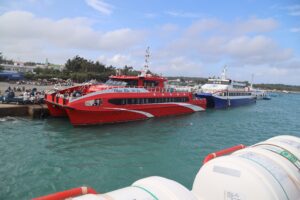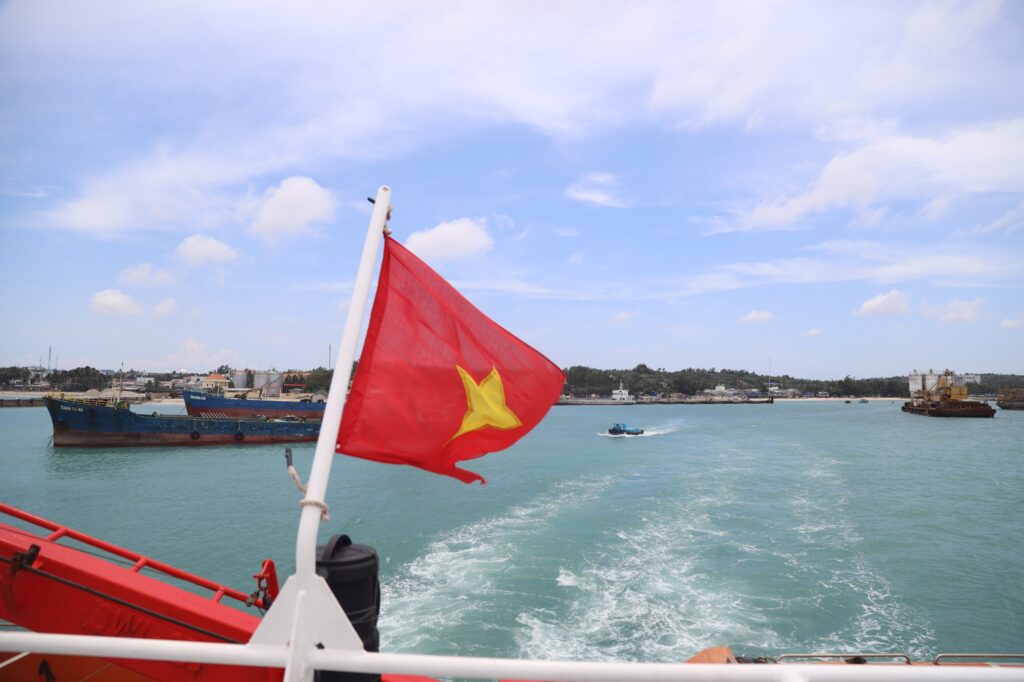In Phu Quy, the neu pole (New Year’s bamboo pole) is not erected on the 23rd day of the twelfth lunar month like in many other localities, but instead on the very last day of the year (the 29th or 30th of the lunar December). It is then taken down on the seventh day of the first lunar month, known as khai ha (the end of the Tet celebration period).
The tradition of setting up the neu pole is considered a solemn and significant event by the island’s inhabitants. Therefore, everything from the preparation to the ceremonial erection is typically carried out by the head of the household. Preparation begins in the days leading up to Tet.
Since there are no large bamboo trees on the island, residents must source dry bamboo from the mainland. The bamboo selected for the neu pole is mature and straight. Once chosen, it is decorated with oil paint to refresh its appearance. Common colors include green, blue, yellow, or sometimes a combination of two.
At the top of the neu pole, islanders hang ritual items: a cluster of bamboo, two betel leaves (one male and one female, placed face to face), two pieces of fresh areca nut, and either two votive paper notes or a large piece of gilded paper. These items are tied to the pole with the fibrous root of the dứa gai (wild pineapple) plant. Notably, near the top of the pole, Phu Quy residents attach a wooden crosspiece carved with symbolic animals—either a dragon or a phoenix—positioned at a 90-degree angle from the pole to hang the national flag. At communal shrines, temples, or village halls, they also hang the flag of the district (a five-colored traditional flag).
Mr. Pham Phuoc of Tam Thanh commune (now deceased, as per a 2016 interview) explained the meaning of these symbols:
“Dragons and phoenixes are two of the four sacred creatures in Vietnamese culture—Long (dragon), Lân (kirin), Quy (turtle), and Phượng (phoenix). One of these sacred creatures is chosen to be placed on the Tet neu pole in Phu Quy. Families usually choose the phoenix, while temples and shrines use the dragon, symbolizing wishes for prosperity and peace in the New Year.”
The neu pole tradition is also practiced symbolically by fishermen, who tie a cluster of bamboo leaves to the flagpole on their fishing boats. For these fishermen, the boat is home, and the fishing grounds are their homeland. Erecting the neu pole with the national flag is not only a prayer for success in the new year but also a declaration of national sovereignty over the seas they work in. Seeing the neu poles waving the red flag with a yellow star, each islander becomes more aware of their role in preserving cultural heritage and defending the nation’s maritime territory.
According to author Do Thanh Danh, some Phu Quy islanders who migrated and settled in Thuan Quy commune (Ham Thuan Nam district) still maintain this tradition today. If they are unable to erect a full neu pole, they tie a few bamboo sprigs and gilded paper together and hang them at their gate as a symbolic gesture.
In spring, visitors to the island are greeted by a “forest” of neu poles flying the red national flag in front of every home. Many are surprised and feel as though they’ve stepped into a mythical land—where the story of the neu pole, once only heard in childhood tales, has come vividly to life. The author of this article is one such person.
By THANH DANH










